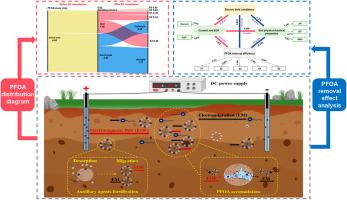阴极强化全氟辛酸污染土壤的电动修复:助剂-增强解吸和迁移
IF 10
1区 环境科学与生态学
Q1 ENGINEERING, ENVIRONMENTAL
引用次数: 0
摘要
电动力学(EK)修复是一种很有前途的原位修复持久性污染物污染土壤的技术,但其效率往往受到污染物解吸和迁移不良的限制。本研究探讨了阴极助剂对pfoa污染土壤的EK修复效果。在解吸试验中,SDS(50.93%)和NaC(43.62%)通过静电、疏水相互作用和胶束形成对PFOA的解吸效果最好,优于DTAB(15.29%)和CA(37.76%)。连续解吸试验验证了使用助剂作为电解质的有效性。EK修复实验表明,这些试剂促进了PFOA的解吸和迁移,达到了更高的去除效率。7 d后,NaC对PFOA的去除率分别为58.04% (2 V/cm)和63.70% (2 V/cm), NaC对PFOA的去除率高于SDS。由于电渗透力和电动能相反,PFOA在中部土壤区积累,其中电迁移是主要因素。延长修复时间减轻了这种积累。动力学分析表明,PFOA在大部分区域的迁移遵循准二级动力学,而中间区域由于PFOA的积累而呈现一级动力学。助剂主要通过影响电迁移、电渗透和解吸过程间接提高PFOA的去除效率,而土壤理化性质的变化是限制因素。本研究为阴极增强EK和助剂对PFOA的联合修复提供了有价值的见解,为开发高效、可持续的修复技术提供了理论和实践指导。本文章由计算机程序翻译,如有差异,请以英文原文为准。

Cathodic enhanced electrokinetic remediation of PFOA contaminated soil: Auxiliary agents-enhanced desorption and migration
Electrokinetic (EK) remediation is a promising in-situ technique for remediating soils contaminated with persistent pollutants, but its efficiency is often limited by poor pollutant desorption and migration. This study explores the use of cathodic auxiliary agents to enhance the EK remediation of PFOA-contaminated soil. Among the desorption tests, SDS (50.93 %) and NaC (43.62 %) were most effective in desorbing PFOA through electrostatic, hydrophobic interactions, and micelle formation, outperforming DTAB (15.29 %) and CA (37.76 %). Continuous desorption tests validated the effectiveness of employing auxiliary agents as electrolytes. EK remediation experiments revealed that these agents facilitated PFOA desorption and migration, achieving higher removal efficiencies. After 7 d, NaC achieved a greater enhancement effect than SDS, with PFOA removal rates of 58.04 % (2 V/cm) and 63.70 % (2 V/cm), respectively. PFOA accumulation in the middle soil area was observed, due to opposing electroosmotic and electrokinetic forces, with electromigration being the dominant factor. Extending remediation time alleviated this accumulation. Kinetic analysis revealed that PFOA migration in most areas followed pseudo-second-order kinetics, while the middle area exhibited first-order kinetics due to PFOA accumulation. The auxiliary agents primarily enhanced PFOA removal efficiency indirectly by influencing electromigration, electroosmosis, and desorption processes, while changes in soil physicochemical properties served as limiting factors. This study provides valuable insights into the combined effects of cathodic-enhanced EK and auxiliary agents on PFOA remediation, offering theoretical and practical guidance for the development of efficient and sustainable remediation technologies.
求助全文
通过发布文献求助,成功后即可免费获取论文全文。
去求助
来源期刊

Journal of Cleaner Production
环境科学-工程:环境
CiteScore
20.40
自引率
9.00%
发文量
4720
审稿时长
111 days
期刊介绍:
The Journal of Cleaner Production is an international, transdisciplinary journal that addresses and discusses theoretical and practical Cleaner Production, Environmental, and Sustainability issues. It aims to help societies become more sustainable by focusing on the concept of 'Cleaner Production', which aims at preventing waste production and increasing efficiencies in energy, water, resources, and human capital use. The journal serves as a platform for corporations, governments, education institutions, regions, and societies to engage in discussions and research related to Cleaner Production, environmental, and sustainability practices.
 求助内容:
求助内容: 应助结果提醒方式:
应助结果提醒方式:


